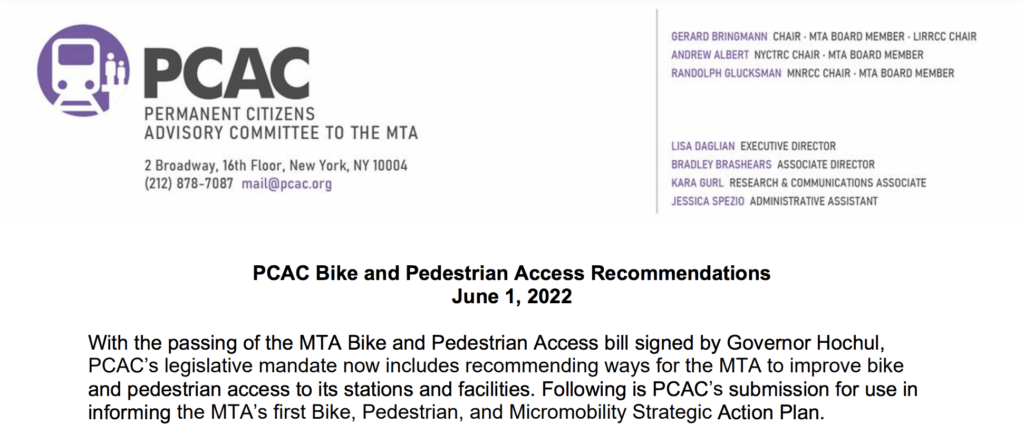With the passing of the MTA Bike and Pedestrian Access bill signed by Governor Hochul, PCAC’s legislative mandate now includes recommending ways for the MTA to improve bike and pedestrian access to its stations and facilities.
PCAC’s recommendations, due and submitted at the beginning of June 2022, include improving bike, scooter and moped parking, fare integration, and clearly communicating the rules for the ride across the system. PCAC is mindful that some of these recommendations will require coordination and communication with other partners in mobility and public safety, including city and state DOTs, local municipalities and transit operators, Community Boards and neighborhood associations, Citi Bike and other bike and scooter share companies, Oonee Pod and other secure bike storage companies, and law enforcement agencies to ensure recommended sites meet safety standards. We’re confident that all stakeholders can work together to improve mobility for riders around the region.
As the MTA develops its Bike, Pedestrian, and Micromobility Strategic Action Plan, we also hope to see a robust public outreach strategy both before and after the plan is drafted, including focus groups and discussions with cyclists and riders. We look forward to continuing to meet our legislative mandate as required under the Bike and Pedestrian Access bill and to working with the MTA and partners to provide ongoing input on improving bicycle and pedestrian access to MTA facilities.
As part of the Bike and Pedestrian Access bill, the PCAC looks forward to welcoming three new members to our Councils with experience and interest in increasing bicycle and pedestrian access to MTA facilities. However, there is no mechanism for appointing the new members to the Metro-North & LIRR Commuter Councils to represent riders who also ride bicycles. We call on our state legislators to remedy this omission during the next legislative session in Albany and clarify which elected official(s) will serve as the nominator of these new members.
PCAC’s recommendations for use in informing the MTA’s first Bike, Pedestrian, and Micromobility Strategic Action Plan include:
New York City Transit
- Explore ways to improve secure bicycle storage at, near, and around transit stations.
- Integrate OMNY with Citi Bike.
- Improve coordination with DOT so that bikes and buses do not conflict with each other on the street, including by separating bus lanes from bike lanes.
- Study bus routes that may benefit from having bike racks on the front of buses, including buses that go over bridges without bicycle access.
- Improve and clarify rules regarding bicycle storage on trains.
- Use decals and stickers on Subway doors and platform floors for recommended bicycle cars.
- Work with Citi Bike, NYC DOT and Community Boards to recommend improvements that will increase transit equity, access and mobility including wayfinding, bike lanes, and Citi Bike locations.
- As the MTA rolls out new neighborhood-level detailed maps at stations, add nearby bike infrastructure.
- Include bike navigation options on the MyMTA app and Trip Planner, and work with other app designers to incorporate information.
- Use data from the ongoing New York Bike Census to monitor areas for improving bike and pedestrian access in the future.
MTA Commuter Rails
- Take advantage of underutilized MTA-owned parking lot space to increase secure bike storage.
- Improve and clarify rules regarding bicycle storage on trains.
- Use decals and stickers on train doors and platform floors for recommended bicycle cars.
- Work with municipalities to develop first- and last- mile micromobility pilot programs.
- Work with municipalities to increase protected bike lanes, sidewalks, and wayfinding signs on roads leading to stations.
The MTA’s commitment to studying ways to make micromobility work for transit riders is encouraging. The First- and Last- Mile study underway to increase bike and scooter share, parking options, and other micromobility options for Long Island Rail Road and Metro-North Railroad riders is an important step, and other recent improvements – including the Oonee Pod pilot at Grand Central and policy changes to eliminate the need for permits for bicycles on Metro-North and LIRR trains outside of rush hour – will also help show cyclists that they are able and welcome to take transit to complete their trips. At the same time, it’s essential that rules and regulations are developed and enforceable to protect rider safety, including riders with disabilities or mobility challenges who may end up competing for the same space on trains and in stations as cyclists, particularly in light of the increasing number of electric-powered e-bikes, e-scooters and even e-mopeds that are being brought into the system.
Cycling should be seen as complementary, rather than competition to, transit. Improving cycling infrastructure around the region does not mean encouraging potential transit riders to forgo their MetroCard or OMNY swipe or train ticket for a bike helmet; instead, it means ensuring that everyone can move around the region quickly, accessibly, and affordably without using a car. Improving the quality of transit and bicycle infrastructure can work hand-in-hand to increase usage of both modes.
CONTACT: Kara Gurl, PCAC: 718-839-3625/ [email protected] Lisa Daglian, PCAC: 917-612-2292/ [email protected]
